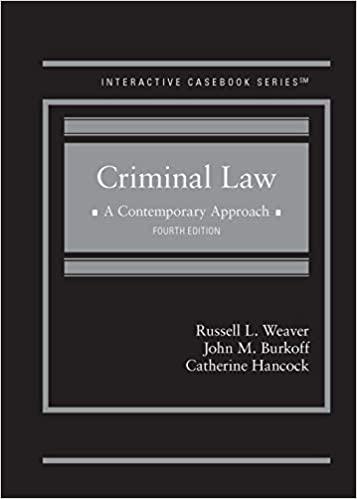Question
1) Hoskin v. West's ratio decidendi is that: a)Unless the shipper declares the true value of the goods being shipped, the carrier's liability is limited
1) Hoskin v. West's ratio decidendi is that:
a)Unless the shipper declares the true value of the goods being shipped, the carrier's liability is limited as provided in the statute
b)When the shipper declares the value of the goods being shipped, the statutory limitation of liability applies to limit the amount of loss
c)The statutory limitation of liability protects the carrier in all circumstances
2)In Saskatoon Gallery & Conservatory v. Deakin Fine Art, fine art was damaged by the negligence of the carrier. However, the carrier claimed that its liability was limited because the shipper did not make a declaration of value in the appropriate box on the bill of lading. This case stands for the principle that:
a)Unless the shipper properly completes the bill of lading, the carrier's liability is limited
b)The bill of lading is void because it was not completed improperly
c)As long as the declared value appears on the face of the bill of lading, the carrier is liable for the loss
d)All of the above
3) In Romoda v. Atomic Transfer, the plaintiff's claim was dismissed because:
a)They did not declare a value on the bill of lading
b)They did not commence their claim within the limitation period
c)They did not provide written notice to the carrier in the appropriate time frames
d)They did not complete the bill of lading correctly
4)In the case of Premium Grain & Seed v. Finora Canada,
a)Finora successfully claimed that the peas had an inherent defect and therefore, the carrier was not negligent
b)CNR successfully proved that Premium Grain & Seed negligently loaded the peas onto the rail car by allowing a beetle to fly into the rail car and infest the peas
c)Premium Grain & Seed successfully proved, on the balance of probabilities, that the peas were in good condition where they were loaded on the rail car and CNR failed to prove that the rail car was not infested at the time of loading, and was, therefore, the cause of the infestation
5) In ABB Power Generation v. CSX Transportation, the issue in the case was regarding what is the most appropriate forum for the legal proceeding. The test that the court uses to determine this is:
a)the connecting factors test
b)Where the jurisdiction of the carrier is
c)Reasonable proximity
d)What the bill of lading says
6) In Huxley v. Aquila, it was held that:
a)An international carriage ticket must cross international borders
b)When two distinct contracts of carriage are issued where part of the trip is domestic and the other part international, it is not considered part of an international carriage contract
c)In order for an air waybill to be considered as part of an international carriage, the tickets must be separately booked by the same agent
7) Calculate the maximum liability for the following good being shipped by boat.
Ten (10) tubes at $25,000 per tube. Each tube weighs 5,000 kilogram. There is no declared value on the bill of lading. Assume 1 SDR = $1.82 Canadian.
a)$12,133.39
b)$250,000
c)$6,666.70
d)$182,000
Step by Step Solution
There are 3 Steps involved in it
Step: 1

Get Instant Access to Expert-Tailored Solutions
See step-by-step solutions with expert insights and AI powered tools for academic success
Step: 2

Step: 3

Ace Your Homework with AI
Get the answers you need in no time with our AI-driven, step-by-step assistance
Get Started


